
|
The region of the Highlands is located in the Northeast of the province of Soria, bordering in the North and in the East with the Community of La Rioja. It has an area of 65825 Has.
It can be divided in three different regions according to the rivers that flow along them and that can be named according to the biggest town that lies in each valley: TIERRA DE MAGAÑA (Magaña Land): : Within the Alhama Valley. TIERRA DE YANGUAS (Yanguas Land): Within the Cidacos Valley. TIERRA DE SAN PEDRO MANRIQUE (San Pedro Manrique Land): Within the Linares Valley. |
PLANTSThree different groups of plant formations are located in the region: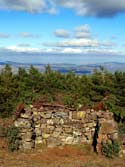 WOODLAND WOODLANDThe most common trees are the pine, the holm oak, the oak, the Portuguese oak and the beech. Among which some others appear more scarcely: maples, ashes, birches, hawthorns... Next to the rivers and villages some poplars and black poplars can be found, as well as some isolated walnut trees. |
 SCRUBLAND SCRUBLANDDifferent bushes can be found in the region due to its large stretch, as well as the different altitudes, climates and grounds. From heather and Spanish gorse in the highest and most acid areas to rosemary, Spanish cedar and alaterno in the warmest places over the limestone, or rockrose (steppe), juniper, Spanish gorse, etc. |
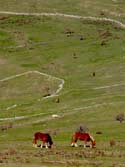 PASTURELAND PASTURELANDSome pastures survive in those areas where the cattle still exists, specially in the highest areas, as most of the cattle used to be transhumance. In most of these areas some hollywood can been found, as it has been preserved during the years, as well as some cattle meadows next to the villages. |
PLANT ECOSYSTEMSWOODLAND
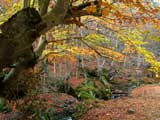 There are some different woodlands: the pinewood, that grows naturally. Since the 60s it has become the most spread forest due to reforestation works. The Scots pine is the most extended, and only some black pines seem to appear in the lowest areas of limestone. Over the warmest areas, some holm oak woods –that were not sold to the Forest Heritage- can be found; some beechwoods in the Northern area; and some oaks and Portuguese oaks forming small woods near the villages as they were used as firewood. Within these vegetal formations, some bushes appear: heathers and thymes in the coldest and most acid areas and rosemary in the lowest, driest areas over the limestone. There are some different woodlands: the pinewood, that grows naturally. Since the 60s it has become the most spread forest due to reforestation works. The Scots pine is the most extended, and only some black pines seem to appear in the lowest areas of limestone. Over the warmest areas, some holm oak woods –that were not sold to the Forest Heritage- can be found; some beechwoods in the Northern area; and some oaks and Portuguese oaks forming small woods near the villages as they were used as firewood. Within these vegetal formations, some bushes appear: heathers and thymes in the coldest and most acid areas and rosemary in the lowest, driest areas over the limestone. |
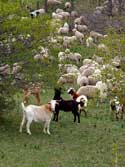 PASTURES ON THE MOUNTAINS PASTURES ON THE MOUNTAINSIn these formations, herbaceous species are predominant. These are not as visible as woods, but during the flowering period the bushes that accompany these species delight us with their amazing and diverse colours that, joint to the cattle, show the real landscape of this region. |
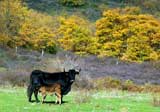 MEADOWS MEADOWSThey are usually pasture areas with some trees dotted around the fields or forming some small forests that most of the times have been used as a shelter for the cattle and others have also served as firewood. Hollywoods and oak woods are the most significant trees in these areas, adding some colour to this landscape. |
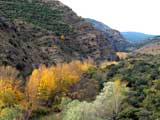 BANK AND RIVERSIDES BANK AND RIVERSIDESThe areas with the highest variety. Poplars and willows are the most common ones, but there are also ashes, hazels and maples that among others colour the riverside. |
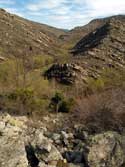 ROCKY PLACES ROCKY PLACESThe lack of land and the hard conditions of these areas made almost impossible the growing of almost any kind of vegetation. Only some small kermes oaks grow on the cracks where some sand has been deposited, as well as few junipers that decorate the wall. And regardless the smallness of the cracks, bracken and sempervivums grow to add an ocher-grayish colour to the rocks. |
ANIMALSMAMMALIAN
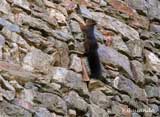  The most widespread group of animals. The herbivorous are the ultimate symbol of mammalians in the area: deer and roe deer, which are easy to find; wild boars, always elusive and among the thickest bushes; foxes running distrustful in every kind of land and representing the highest predatory of the region. The most widespread group of animals. The herbivorous are the ultimate symbol of mammalians in the area: deer and roe deer, which are easy to find; wild boars, always elusive and among the thickest bushes; foxes running distrustful in every kind of land and representing the highest predatory of the region.
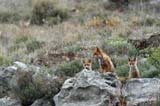 Another group is the one of small mammalians, which are most unknown –as they are more elusive and difficult to find- but very important within the fauna of the area: squirrels in the woods, wild cats, civet cats, ferrets, stone martens and weasels as depredators; badgers, very difficult to meet because of their night habits; hedgehogs, in fresh areas such as riversides but whose population is decreasing; and bats as the only flying mammalian in the region. Another group is the one of small mammalians, which are most unknown –as they are more elusive and difficult to find- but very important within the fauna of the area: squirrels in the woods, wild cats, civet cats, ferrets, stone martens and weasels as depredators; badgers, very difficult to meet because of their night habits; hedgehogs, in fresh areas such as riversides but whose population is decreasing; and bats as the only flying mammalian in the region.
|
|
BIRDS
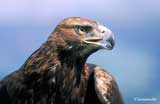 There are lots of different birds in this region, from small insectivorous birds to big birds of prey and carrion birds.
There are lots of different birds in this region, from small insectivorous birds to big birds of prey and carrion birds.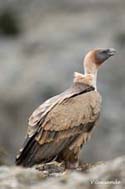 Among the small ones, it is remarkable the bright plumage of the golden oriole, the goldfinch, the bee-eater, the hoopoe, etc. The tits and coal tits flying from one branch to another, the constant pecking of the woodpecker, the noisy caw of the jays, the swallows and the common house martin and their elaborate nests, etc. On the banks of the river, some kingfisher, ducks and few egrets and woodcocks. As well as partridges followed by their broods running along the paths. Among the small ones, it is remarkable the bright plumage of the golden oriole, the goldfinch, the bee-eater, the hoopoe, etc. The tits and coal tits flying from one branch to another, the constant pecking of the woodpecker, the noisy caw of the jays, the swallows and the common house martin and their elaborate nests, etc. On the banks of the river, some kingfisher, ducks and few egrets and woodcocks. As well as partridges followed by their broods running along the paths. 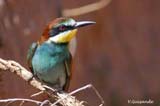 There is also a distinction between diurnal and nocturnal birds of prey. Among the diurnal ones we can find some golden eagles, red kites or common buzzards, as well as some serpent eagles and booted eagles (while they are living in this region), goshawks flying over the mountains and near the villages, some common krestel with their particular way of flying. And among the nocturnal ones the Eurasian eagle owl (close to the sheer walls), the barn owls (breathing deep on the belfries) and small European scops owl, Tengmalm's owls and hawk owls. There is also a distinction between diurnal and nocturnal birds of prey. Among the diurnal ones we can find some golden eagles, red kites or common buzzards, as well as some serpent eagles and booted eagles (while they are living in this region), goshawks flying over the mountains and near the villages, some common krestel with their particular way of flying. And among the nocturnal ones the Eurasian eagle owl (close to the sheer walls), the barn owls (breathing deep on the belfries) and small European scops owl, Tengmalm's owls and hawk owls. The griffon vulture is the most important carrion bird, thanks to its majestic flight all over the region. From time to time some Egyptian vulture can be seen nesting on the sheer walls. |
REPTILIANS AND AMPHIBIANS 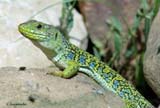 Although these animals are even more difficult to see, a lot of reptilians and amphibians live in this region. It is worth to mention the newts on the deep waters of the highest mountains; frogs croaking and jumping on the ponds of the gullies; wall lizards, ocellated lizards sunbathing and the so feared viper on the paths, Montpellier snakes, and ladder snakes in fresh areas with a lot of vegetation; natrix mauras swimming on the rivers, and the so feared anguis fagilis (or slow worms) which are in fact lizards, not snakes. Although these animals are even more difficult to see, a lot of reptilians and amphibians live in this region. It is worth to mention the newts on the deep waters of the highest mountains; frogs croaking and jumping on the ponds of the gullies; wall lizards, ocellated lizards sunbathing and the so feared viper on the paths, Montpellier snakes, and ladder snakes in fresh areas with a lot of vegetation; natrix mauras swimming on the rivers, and the so feared anguis fagilis (or slow worms) which are in fact lizards, not snakes.
Written by Arturo Calleja Palacios |

© Tourist Initiatives Center of the Highlands (Soria, Spain) 2009













